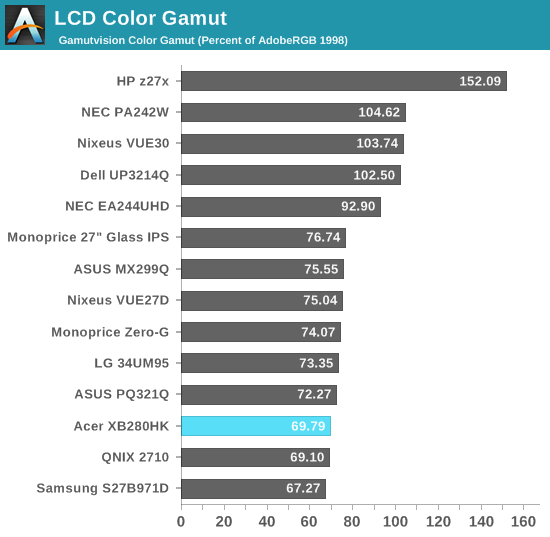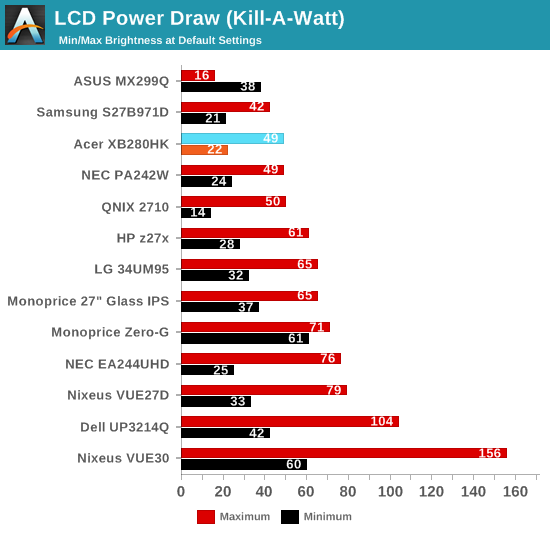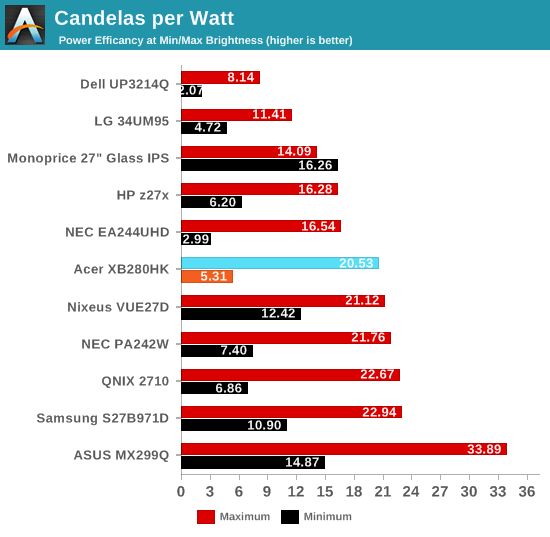Acer XB280HK 4K G-SYNC Monitor Review
by Chris Heinonen & Jarred Walton on January 28, 2015 10:00 AM ESTAcer XB280HK: Input Lag, Gamut, and Power Use
Like the other G-SYNC displays I have tested, the Acer 4K has no inputs aside from a single DisplayPort. Because I have no CRT monitor that can run at the same native resolution as it, nor a DisplayPort compatible lag tester, I can’t produce an accurate input lag measurement for the display. Obviously this is not an ideal result for a gaming display, but any number I could produce I would have zero faith in.
Color gamut shows just under 70% of the AdobeRGB color space, or a bit short of the sRGB gamut. As we saw that red is a bit under-saturated when looking at the CIE diagram, this result comes as no surprise. It’s very close so it won’t be really noticeable, and you likely won’t use the Acer for serious image editing anyway.

With the backlight at maximum on a solid white screen, the Acer consumes 49 watts of power. Set the backlight down to minimum and that falls to only 22 watts. This is well below the other 4K displays we have tested, though those all use IPS panels instead of TN. It also shows that the G-SYNC hardware, at least on these static tests, does not seem to consume a lot of extra power compared to a regular display.












69 Comments
View All Comments
inighthawki - Friday, January 30, 2015 - link
In what way is it incorrect?perpetualdark - Wednesday, February 4, 2015 - link
Hertz refers to cycles per second, and with G-Sync the display matches the number of cycles per second to the framer per second the graphics card is able to send to the display, so in actuality, Hertz is indeed the correct term and it is being used correctly. At 45fps, the monitor is also at 45hz refresh rate.edzieba - Wednesday, January 28, 2015 - link
"We are still using DisplayPort 1.2 which means utilizing MST for 60Hz refresh rates." Huh-what? DP1.2 has the bandwidth to carry 4k60 with a single stream. Previous display controllers could not do so unless paired, but that was a problem at the sink end. There are several 4k60 SST monitors available now (e.g. P2415Q)..TallestJon96 - Wednesday, January 28, 2015 - link
Sync is a great way to make 4k more stable and usable. However, this is proprietary, costs more, and 4k scaling is just ok. Any one interested in this is better off waiting for a better, cheaper solution that isn't stuck with NVIDIA.As mentioned before, the SWIFT is simply a better option, better performance at 1440p, better UI scaling, higher maximum FPS. Only downside is lower Res, but 1440p certainly isn't bad.
A very niche product with a premium, but all that being said I bet Crisis at 4k with G-Sync is amazing.
Tunnah - Wednesday, January 28, 2015 - link
"Other 4K 28” IPS displays cost at least as much and lack G-SYNC, making them a much worse choice for gaming than the Acer. "But you leave out the fact that 4K 28" TN panels are a helluva lot cheaper. Gamers typically look for TN panels anyway because of refresh issues, so the comparison should be to other TN panels, not to IPS, and that comparison is G-SYNC is extremely expensive. It's a neat feature and all, but I would argue it's much better to spend the extra on competent graphics cards that could sustain 60fps rather than a monitor that handles the framerate drop better.
Tunnah - Wednesday, January 28, 2015 - link
Response time issues evenMidwayman - Wednesday, January 28, 2015 - link
If it ran 1080 @ 144hz as well as 4k@ 60hz this would be a winning combo. Getting stuck with 60hz really sucks for FPS games. I wouldn't mind playing my RPGs at 40-60fps with gsync though.DanNeely - Wednesday, January 28, 2015 - link
"Like most G-SYNC displays, the Acer has but a single DisplayPort input. G-SYNC only works with DisplayPort, and if you didn’t care about G-SYNC you would have bought a different monitor."Running a second or third cable and hitting the switch input button on your monitor if you occasionally need to put a real screen on a second box is a lot easier than swapping the cable behind the monitor and a lot cheaper than a non-VGA KVM (and the only 4k capable options on the market are crazy expensive).
The real reason is probably that nVidia was trying to limit the price premium from getting any higher than it already is, and avoiding a second input helped simplify the chip design. (In addition to the time element for a bigger design, big FPGAs aren't cheap.)
JarredWalton - Wednesday, January 28, 2015 - link
Well, you're not going to do 60Hz at 4K with dual-link DVI, and HDMI 2.0 wasn't available when this was being developed. A second input might have been nice, but that's just an added expense and not likely to be used a lot IMO. You're right on keeping the cost down, though -- $800 is already a lot to ask, and if you had to charge $900 to get additional inputs I don't think most people would bite.Mustalainen - Wednesday, January 28, 2015 - link
I was waiting for the DELL P2715Q but decided to get this monitor instead(about 2 weeks ago). Before I got this I borrowed a ASUS ROG SWIFT PG278Q that I used for a couple of weeks. The SWIFT was probably the best monitor that I had used until that point in time. But to be completely honest, I like the XB280HK better. The colors, viewing angles (and so on) are pretty much the same(in my opinion) as I did my "noob" comparison. My monitor has some minor blb in the bottom, barely notable while the SWIFT seems "flawless". The SWIFT felt as is was built better and has better materials. Still, the 4k was a deal breaker for me. The picture just looks so much better compared to 1440p. The difference between 1440p and 4k? Well after using the XB280HK I started to think that my old 24" 1200p was broken. It just looked as it had these huge pixels. This never happened with the SWIFT. And the hertz? Well I'm not a gamer. I play some RPGs now and then but most of the time my screen is filled with text and code. The 60hz seems to be sufficient in these cases. I got the XB280HK for 599 euro and compared to other monitors in that price range it felt as a good option. I'm very happy with it and dare to recommend this to anyone thinking about getting a 4k monitor. If IPS is your thing, wait for the DELL. This is probably the only regret I have(not having patience to wait for the DELL).I would also like to point out that the hype of running a 4k monitor seems to be exaggerated. I manage to run my games at medium settings with a single 660 gtx. Considering I run 3 monitors with different resolutions and still have playable fps just shows that you don't need a 980 or 295 to power one of these things(maybe if the settings are maxed out and you want max fps).